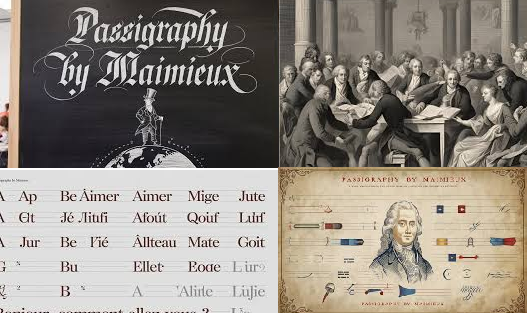Passigraphy, a term coined from Greek roots meaning “universal writing,” refers to a system of universal communication that uses symbols or pictograms to convey ideas across different languages. Developed by Joseph de Maimieux, a French officer and intellectual in the late 18th century, passigraphy was an ambitious attempt to create a language that anyone could understand, regardless of nationality or spoken language. Maimieux’s vision stemmed from the Enlightenment ideals of universal understanding and harmony, and he believed that his system could bring humanity closer by overcoming language barriers.
Who Was Joseph de Maimieux?
Joseph de Maimieux (1753–1820) was a French military officer, philosopher, and polyglot who held a fascination for the concept of a universal language. Inspired by the works of philosophers like Gottfried Wilhelm Leibniz, who proposed ideas for a “characteristica universalis” (universal characteristic language), Maimieux developed passigraphy as a way to communicate without words. His method went beyond translation and sought to create a visual language that could be understood intuitively.
The Principles Behind Passigraphy
Maimieux’s approach was based on a set of symbols that represented common ideas or concepts. Instead of forming complex grammar rules or vocabulary, he opted for a simple and straightforward design. This system aimed to be logical and easy to understand for people from various linguistic backgrounds. Here are some of the core principles of passigraphy:
- Universal Symbols: Maimieux created symbols for common ideas such as time, space, emotions, and objects. By using these universal symbols, he believed individuals could communicate without needing to learn each other’s languages.
- Logical Structure: Each symbol was designed with a logic that made it easy to decipher. For example, a symbol representing “house” would not need to follow the phonetic structure of any language; instead, it would be visually representative and straightforward.
- Global Accessibility: Maimieux’s vision for passigraphy was to create a system that could be understood by anyone, regardless of literacy or educational background. He saw passigraphy as a tool that could empower people by breaking down social and linguistic barriers.
- Elimination of Ambiguity: Unlike spoken languages that can have multiple meanings or nuances, passigraphy aimed to be clear and specific, reducing misinterpretations.
Passigraphy and the Enlightenment
Maimieux’s work emerged during the Enlightenment, a period of significant intellectual development and exploration of human rights, equality, and unity. Thinkers of the time believed that knowledge and ideas should transcend borders and that language was a limiting factor in achieving global understanding. In this spirit, Maimieux saw passigraphy as a bridge toward unity and a means of facilitating communication between people who spoke different languages.
The Development and Publication of Passigraphy
Maimieux published his work, titled Pasigraphie, in 1797. His book outlined the structure of passigraphy and included examples of symbols and their meanings. He demonstrated how people could use these symbols in daily communication, believing his system would foster a sense of shared humanity and promote peace. His work received some attention but struggled to gain widespread traction due to limited access and the complex nature of creating a new linguistic standard.
Challenges and Criticisms of Passigraphy
While Maimieux’s passigraphy was a groundbreaking idea, it faced several challenges:
- Adoption and Implementation: Creating a universal language is a vast undertaking, and Maimieux’s passigraphy needed global support to gain relevance. The lack of a practical means to spread and teach the language made it difficult for the system to take root.
- Complexity of Human Expression: Passigraphy was ideal for basic communication but struggled to express complex ideas, emotions, and abstract thoughts. Languages evolve over time to accommodate cultural and societal nuances, something passigraphy could not fully capture.
- Competition from Other Languages: The growing use of languages like English and French as lingua francas (bridge languages) made passigraphy less relevant. Trade, diplomacy, and colonization had already established certain languages as default means of international communication.
- Evolution of Modern Linguistic Theory: Later linguists and philosophers, such as Ferdinand de Saussure, emphasized the complexity of language and its deep ties to culture. This understanding cast doubt on whether a universal language was achievable or even desirable.
The Legacy of Maimieux’s Passigraphy
Though passigraphy did not become a widely adopted system, Maimieux’s ideas had a lasting impact on the field of constructed languages, known as conlangs. His work laid the groundwork for other universal language projects, such as Esperanto, which sought to create a simple, neutral language that could be learned easily. Passigraphy also inspired modern icons and visual languages used in transportation, technology, and international signage, where clear and simple imagery is necessary for fast, global comprehension.
Modern Reflections on Passigraphy
Today, Maimieux’s ideas echo in the language of symbols and icons that fill digital and real-world environments. From emojis to universal signs, the concept of using visual representations to overcome language barriers has become more relevant. Though technology has taken passigraphy’s place as a means of breaking down linguistic borders, Maimieux’s vision remains inspiring. The desire for a universal language persists, and technology is bringing it closer to reality through tools like real-time translation apps and AI-driven language models.
Conclusion
Passigraphy by Maimieux was an ambitious endeavor that highlighted the potential for human connection beyond language. His vision remains a testament to the Enlightenment ideals of unity and universal understanding. While passigraphy as a system did not achieve widespread use, it contributed to the ongoing exploration of universal communication. Maimieux’s legacy continues to inspire efforts toward breaking down linguistic barriers, proving that even in a world divided by languages, the dream of a shared human language is never entirely out of reach.
Read more :
1= https://rapidurlindexer.net/blogs/your-potential-with-narissa-thelo-fitness-and-wellness-insights/
3= https://rapidurlindexer.net/blogs/top-huriyer-insights-what-you-need-to-know/
5= https://rapidurlindexer.net/blogs/eta-2671-vs-2550-understanding-the-eta-movements-in-watchmaking/
6= https://rapidurlindexer.net/blogs/passigraphy-by-maimieux-a-universal-language-vision/



